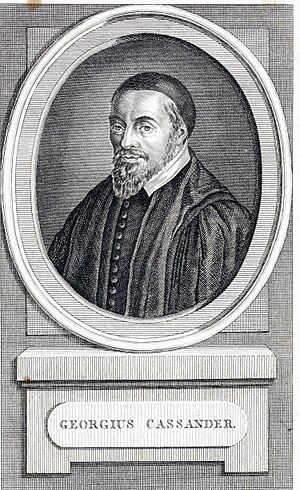George Cassander facts for kids
George Cassander (1513 – 3 February 1566) was a Flemish Catholic theologian and humanist. A theologian studies religion and God, while a humanist focuses on human values and achievements. Cassander is known for trying to bring different Christian groups back together during a time of religious conflict.
Contents
Early Life and Studies
George Cassander was born in 1513 in Pittem, a town near Bruges. When he was young, he moved to Leuven to study. He finished his studies there in 1533.
In 1541, Cassander became a professor in Bruges, teaching subjects like literature and language. However, he left this job just two years later. He wanted to travel and learn more. Also, some people disagreed with his ideas about changing the church, which were seen as supporting the Reformation.
Travels and Focus on Religion
Cassander traveled with his friend, Cornelius Wouters. They visited places like Rome. In 1544, he arrived in Cologne and decided to live there permanently by 1549.
In Cologne, Cassander changed his focus from classical studies to the Bible and church matters. He wrote many books about the Bible and early church teachings. By 1556, he started writing about church services and rituals.
Working for Christian Unity
Cassander deeply studied the differences between the Catholic and Protestant churches. He strongly believed in bringing them back together. He worked hard on this idea, even before others like Gottfried Leibniz had similar thoughts.
A historian named Jacques Auguste de Thou described Cassander as a humble person. He said Cassander truly wanted religious groups to unite. He was willing to make many compromises to achieve this goal, while still remaining a Catholic.
Cassander passed away in Cologne on February 3, 1566. All his writings were later collected and published in 1616.
Efforts for Religious Peace
Cassander's work to create peace between Catholics and Protestants began in 1561. He published a book called De officio pii viri in hoc religionis dissidio. This book was published without his name on it.
A Book for Both Sides
This book was written at the request of a lawyer named François Baudouin. It was even shown at a meeting called the Colloquy of Poissy in September 1561. However, the book ended up upsetting both Catholics and Protestants.
Cassander believed that no one should completely destroy the Church because of its problems. But he also showed he disliked those who made the Pope's power seem too great. He based his views on the Bible, explained by the traditions and writings of early church leaders from the first six centuries. He didn't expect a full reunion but suggested churches agree on the main ideas of early Christian teachings.
Advice to the Emperor
At a time when arguments were very loud, a book like Cassander's didn't fully please anyone. But some German princes thought he could help fix the divide. Because of this, Emperor Ferdinand asked him to publish another work.
This book was called Consultatio de Articulis Fidei lute, Catholicos et Protestantes Controversis (1565). In it, Cassander tried to explain the Augsburg Confession (a key Protestant statement) in a way that Catholics could understand. He suggested that beliefs should be based on the Bible. If a text was unclear, it should be understood using the interpretations of early church leaders from the first six centuries.
In 1564, the Emperor also asked Cassander to go to Duisburg. There, he discussed the topic of infant baptism and the Anabaptists, another religious group.
Reception of His Work
Cassander never attacked core church beliefs. He even favored the Roman Catholic Church because of its long history and authority. However, he did criticize the Pope's power and some church practices.
His work was strongly attacked by theologians from Leuven. It was also criticized by Protestant leaders like John Calvin and Theodore Beza. Because of these strong reactions, Cassander's book was placed on the Roman Index in 1617. This meant Catholics were forbidden from reading it.


